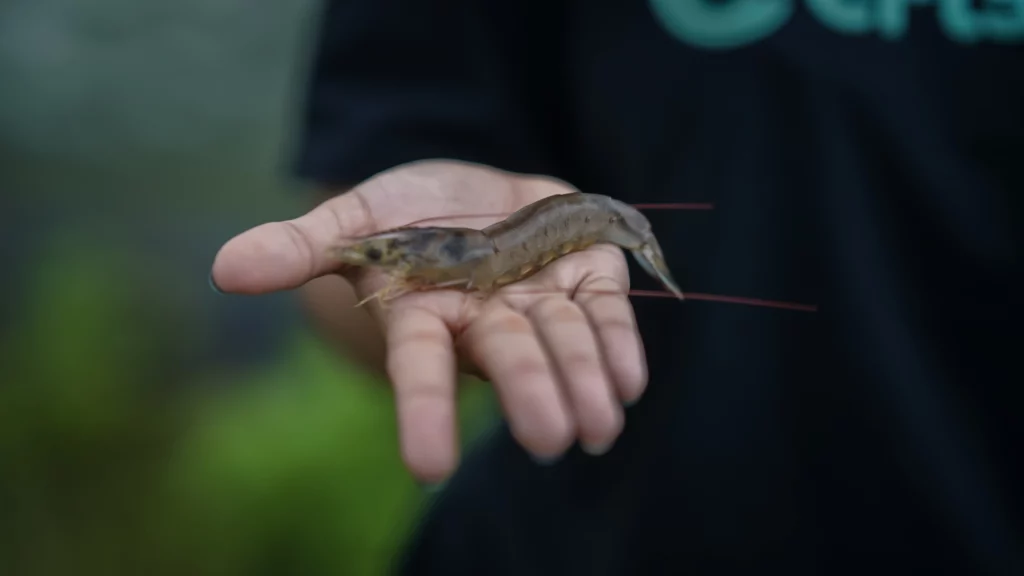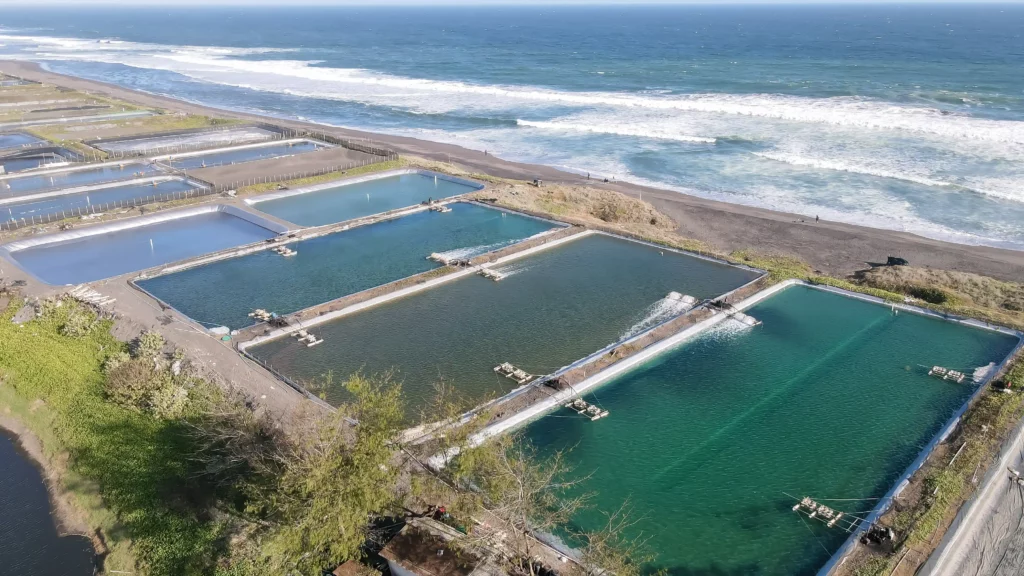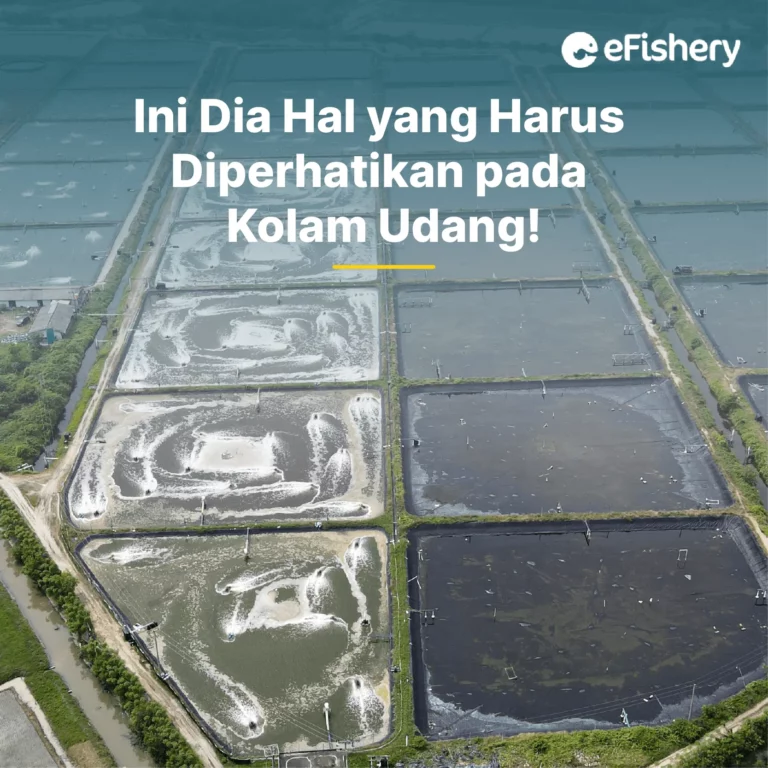Shrimp quality is not only determined by the treatment, but also related to the intensity of the shrimp pond. One of the conditions for maximum shrimp cultivation is a quality pond.
Ponds are crucial in shrimp farming. Therefore, proper treatment is needed to make the quality of the pond better. There are many efforts that you have to do so that the shrimp get a quality pond as a place to live.
Types of Shrimp Cultivation Ponds

In shrimp farming, you need to pay attention to the shrimp farming pond, both from the type of pond to be used or how to maintain the quality of the shrimp pond water.
The type of pond that you use will affect the amount of shrimp stocking capacity. The larger the size of the pond that you use, the more shrimp stocking population will also be.
1. Concrete Pool
The advantages of concrete or cement ponds for shrimp farming are that they are more sterile, safer from pest attacks, and can be used for a longer period of time than other types of ponds.
Even though it has advantages, using a concrete pool has disadvantages, namely it requires a lot of money and takes a long time to make.
2. Tarpaulin Pool
Tarpaulin can be used as a material for making ponds for shrimp farming. Tarpaulin ponds are widely used by shrimp farmers in Indonesia because tarpaulin ponds are easy to make and cheaper.
The drawback of tarpaulin pools is that they leak and collapse easily, and the way to overcome this risk is to use quality tarpaulin and build a pool with a sturdy frame. Also make sure there are no sharp rocks before the tarpaulin is spread out, so the tarpaulin doesn't tear.
3. Ground Pool
The advantage of using earthen ponds is that the manufacturing process is easier, only by digging a hole wide enough to be used as a shrimp pond.
However, earthen ponds are very susceptible to attack by pests. Not only that, the quality of the land also affects the development of shrimp. Poor soil quality will reduce water quality, thereby inhibiting shrimp growth.
Things to Look For in Shrimp Ponds

In addition to the type of pond, the following are factors that need to be considered in aquaculture ponds:
1. Selection of Shrimp Cultivation Pond Locations
When you want to pursue shrimp farming, the thing to consider is the location of the cultivation. You must ensure that the location of the selected pool is free from water pollution.
Therefore, there are several requirements that you must pay attention to when choosing the location of a shrimp farming pond:
- Choose a location that has an adequate supply or source of water.
- Avoid areas where the water quality fluctuates.
- Choose a location that has the potential to have a long period of cultivation sustainability.
- Choose a location that is integrated with the surrounding community.
- Prospective pond locations must be able to be built without causing negative effects on nature.
After you pay attention to the conditions above, you are required to study the written rules contained in the Regulation of the Minister of Maritime Affairs and Fisheries of the Republic of Indonesia number 75 as follows:
- Located in a coastal area with 2-3 meter tidal fluctuations.
- Avoid flooding.
- The soil type is clayey mud or sandy mud textured, with a sand content of less than 20%.
- Fresh water source with large capacity.
- Far away from toxic and dangerous waste pollution.
- The location of the pond should be 50-150 meters from the beach.
- Consider the function of conservation and minimize disturbance to the surrounding environment.
- Around the location a must have greenbelt as a buffer zone in the form of mangrove forests.
2. Preparation of Tools and Materials
In shrimp farming, you need to prepare the tools and materials used to start the nursery process to the harvest process. The preparation of tools and materials is adjusted to the area of the pond and the number of shrimp seeds being cultivated. To find out how to cultivate shrimp from start to finish, you can read the following article.
3. Water Management
In order for the shrimp to grow well, you need to pay attention to water management issues. To minimize the risks that may occur during shrimp farming, you can pay attention to several things, such as:
- Ensure that the water in the pool is always flowing for maintenance. Water is always replaced with a 30-50% percentage of new water added to the old water.
- The pH is measured periodically and kept between 7.8-8.5.
- The minimum temperature of pool water is around 28-30 ℃ with a minimum dissolved oxygen level of 4 ppm.
- Salinity ranges from 27-30 ppt.
How to Maintain Shrimp Pond Water Quality
Water problems in shrimp farming ponds are the main thing to consider in maximizing shrimp farming. Pool water quality is not only judged by its cleanliness, you need good water management to maintain pool water quality.
Here's how to maintain the quality of shrimp pond water:
1. Good Water Quality Parameters
Water quality parameters in ponds are not constant all the time. However, water quality parameters can be controlled so that they are always within the range that can be tolerated by shrimp and provide good growth.
Good conditions will minimize the process of converting feed into energy, so that more of the feed eaten will be converted into meat. In water management, it is necessary to measure the quality of pond water regularly and routinely, so that pond conditions are always optimal.
Table of Optimal Water Quality Range in Shrimp Ponds
| No. | Parameter | Optimum Value |
| 1 | Brightness | 20-40 cm |
| 2 | Temperature | 28-30℃ |
| 3 | Salinity | 27-30 ppt |
| 4 | Water Height | 130-150cm |
| 5 | Water Color | Green |
| 6 | pH | 7,8-8,5 |
| 7 | DO | > 4 ppm |
| 8 | Alkalinity | 120-150 ppm |
| 9 | TAN | 0.1-1.8 ppm |
| 10 | Ammonia | <0.25 ppm |
| 11 | Nitrite | < 3 ppm |
| 12 | Nitrate | < 50 ppm |
| 13 | Phosphate | >0.75 ppm |
| 14 | TOM | 40-85 ppm |
| 15 | Plankton | GA ± 80% |
Measurement of water quality parameters can be done every day for physical parameters, while chemical and biological parameters can be done at least once a week. This is done to save budget in checking water quality.
Table of Frequency of Measurement of Water Quality Parameters
| Daily Measurements | Weekly Measurement |
| pH | Alkalinity |
| Salinity | TOM |
| Temperature | Nitrates and Nitrites |
| DO | Ammonium and Ammonia |
| Water Height | Phosphate |
| Brightness | Floc |
| Water Color | Plankton |
| Weather Conditions | Bacteria |
Changes to water quality parameters can be done in several ways treatments. By maintaining the quality of pond water, you can improve and support the success of shrimp farming.
Table Treatmentt What to Do When There Is a Change in Water Quality Parameters
| Parameter Change | Treatment |
| low DO |
|
| low pH | Do liming until the optimal pH |
| high pH | Perform water changes gradually |
| Brightness below 20 | Do the addition of water or dilution |
| Brightness above 40 | Perform follow-up fertilization |
| Salinity too low | Give KCL at a dose of 1 ppm |
| The death of algae / klekap floating on the surface of the pool water | Do the cleaning by scraping and throwing it into the disposal |
| Changes in water quality that cause mass molting | Can be anticipated with the use of dolomite or the addition of minerals |
| The accumulation of organic matter at the bottom | Do siphoning or pool cleaning by sucking it through a gravity system |
| Reducing the effect of leftover feed on water quality degradation | Can apply the biofloc method, by adding molasses as much as 1.5-2% of the total feed, done 2 times a week |
2. Good Feed Management
Feed management and water quality have a close relationship and influence each other. Poor feed management will affect water quality. Water quality affects growth, health level, and shrimp survival. Poor water quality due to poor feed management can cause shrimp to experience stress and decreased immunity, easy pathogens to develop, and potential for disease.
3. Provide Probiotics
Probiotics are microorganisms that are bred and applied through feed and the environment. Probiotics function to strengthen the immune system of shrimp and improve water quality.
Probiotics for shrimp farming ponds can help the decomposition process by breaking down organic matter, inhibiting pathogens, and maintaining the stability of water quality parameters.
Consult Shrimp Ponds or Ponds with Cultivation Consultations at eFarm!
Need Help Regarding Shrimp Cultivation Business?
Fill in your personal data in the following form. Our team will immediately contact you via the number cellphone attached. Make sure the data entered is correct.
Ladies and Gentlemen, those are the things that must be considered in shrimp ponds. By paying attention to and maintaining the quality of shrimp pond water, the productivity of shrimp farming can increase.
Are you still confused about shrimp farming? Relax, the best choice for consulting shrimp farming is eFarm!
eFarm is a platform that offers complete solutions for shrimp farmers. Here, you can consult about cultivation constraints with experts and practitioners at eFishery easily, directly through the application eFarm.
Cultivation Consultation is a feature for shrimp farmers who are confused about taking care steps for their ponds or ponds. Through this feature, you can consult about ponds or shrimp ponds so you can get the right treatment steps for optimal shrimp cultivation.
Come on, consult the problems of shrimp farming with features Cultivation Consultation in eFarm! Downloads eFarm on Google Play Store right now!
- https://www.slideshare.net/iwakspeed/pengelolaan-kualitas-air-pada-budidaya-udang-vannamei
- https://mcp-indonesia.com/pemilihan-lokasi-tambak-udang-ada-tips-dan-triknya/
- https://gdm.id/kolam-udang-vaname/
- https://tambakudang.com/5-aspek-yang-perlu-diperhatikan-dalam-budidaya-udang-galah/
